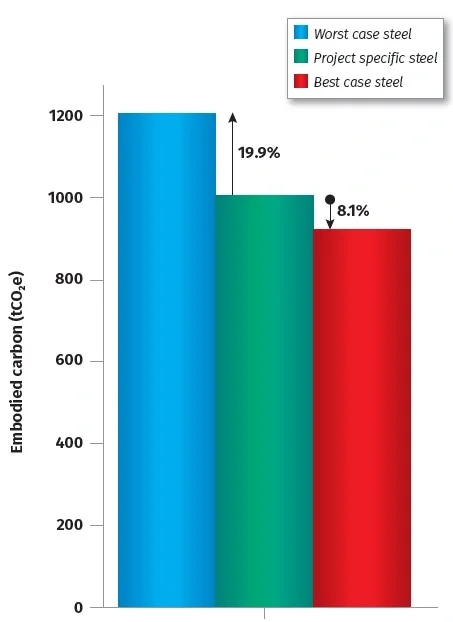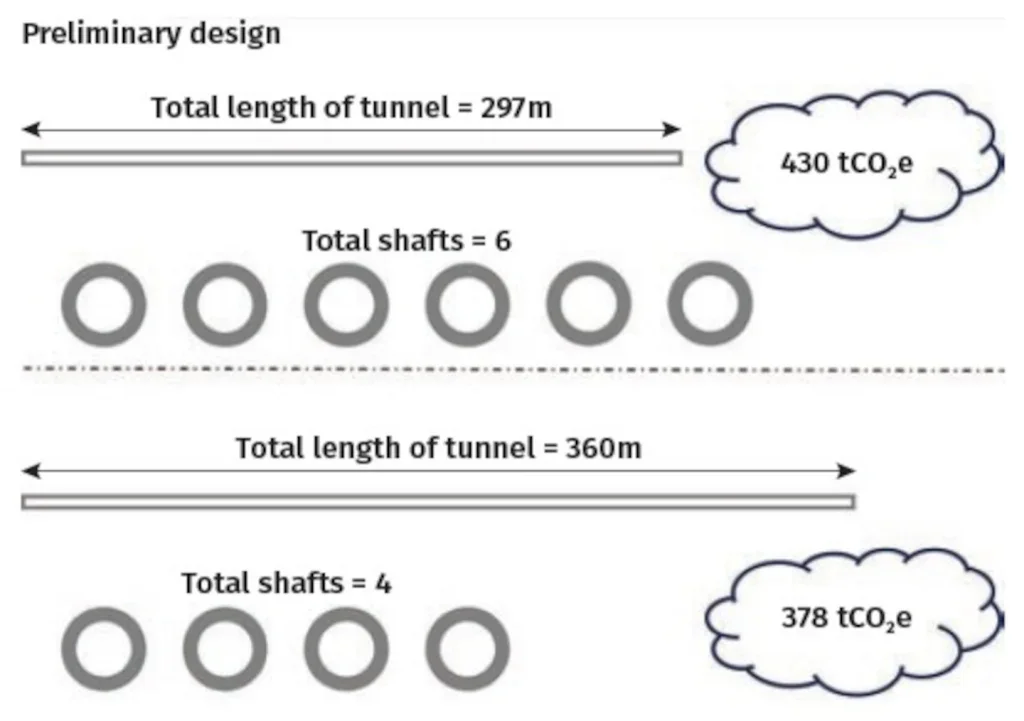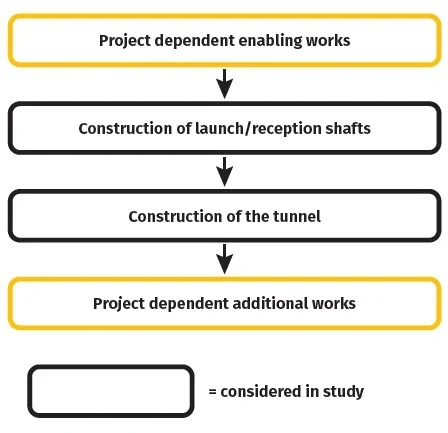
The impetus for this article stems from two compelling facts. Firstly, the creation of new water and wastewater infrastructure is essential. Secondly, it is a critical priority to minimise carbon emissions associated with constructing this new infrastructure.
Microtunnelling is a trenchless method that will play a key role in the construction of future pipelines. In microtunnelling, drives commence and terminate in preinstalled shafts. A tunnel boring machine (TBM) carries out excavation, with the tunnel created by a string of pipes jacked behind the machine.
Despite the important role trenchless methods play in creating necessary utility infrastructure, existing published research fails to comprehensively consider all contributors to the embodied carbon. Many of the published studies consider onsite emissions only, neglecting the embodied carbon of materials used. Some studies do consider both onsite emissions and materials (e.g., Piratla et al. 2012; Khan and Tee 2015; Chilana et al. 2016; Kyung et al. 2017; Alsadi and Matthews 2020), however none of these studies focus on microtunnelling. Only two studies specifically considering microtunnelling were identified by the authors (Lu et al. 2020; Matar et al. 2019), both of which fail to give a holistic insight into the embodied carbon of microtunnelling.

Working in collaboration with Ward and Burke Construction Ltd., we set out to address these shortfalls in understanding by analysing the embodied carbon of three recent microtunnelling projects undertaken in the UK.
All three of these projects were undertaken using reinforced concrete pipes and open-dug caissons for the launch and reception shafts.
SCOPE OF THE RESEARCH
The scope of the study, was designed to enable effective comparison of microtunnelling as an isolated process.
Work required onsite prior to tunnelling will vary hugely dependent on the location and the nature of the project. Similarly, construction activities following the completion of tunnelling will heavily depend on the final application of the pipeline, for example as a gravity sewer or as a carrier for other utility infrastructure.
To negate these differences project to project, only the ‘core’ processes of microtunnelling were considered, namely construction of the shafts and the tunnel itself. Calculations considered the following operations: raw material supply; transport of raw materials to manufacturing facilities; manufacturing processes; transport to site; and, onsite activities.

CASE STUDY RESULTS
The aggregated results for the three case studies analysed are presented in Figure 1. The projects created a total of 870m of new pipeline, the creation of which produced a total of 1005tCO2e (tonne of CO2 equivalent, known as ‘embodied carbon’). This represents an average of 1.16tCO2e per metre tunnelled. To contextualise the scale of these emissions, driving a petrol car for 10,000 miles ~3tCO2e (only considering fuel use; IStructE 2020).
Figure 1 shows that both tunnels and shafts make a significant contribution to the embodied carbon of microtunnelling projects. Materials are shown to dominate emissions, making an especially large contribution to the embodied carbon of the tunnels – despite the total volume of concrete used in the pipes being lower than in the shafts. This is due to the reinforced concrete pipes using C50/60 concrete (with high cementitious content) and dense reinforcement, demonstrating improvement in pipe design could be a key area for enabling reduced embodied carbon.
The embodied carbon from transport to site is also much higher for the tunnels – this is due to the precast facilities being much farther from site than in-situ concrete suppliers for the shafts, demonstrating the significant impact of establishing local suppliers wherever possible. It’s also worth noting the onsite emissions are considerably higher than in other construction sectors – e.g. IStructE (2020) suggests this may be as low as 1%-2% for buildings.

All the projects were carried out by powering the TBM using diesel generators. If mains power was to be used, analysis based on current UK electricity supply (DEFRA 2022) suggests that the embodied carbon due to TBM operation could be reduced by 39%.
STRUCTURAL MATERIALS: INFLUENCE OF STEEL
Materials accounted for 68.5% of embodied carbon across all three projects. Concrete accounted for the majority (58%) of these emissions. This will hardly surprise readers, given the environmental impact of concrete is so well publicised. Steel, despite also being carbon intensive, rarely receives as much limelight.
Steel products, including both reinforcement and steel plate fabrications, accounted for 35.9% of embodied carbon from materials across all three projects.
For the present projects, the reinforcement was sourced from ‘lower embodied carbon’ European suppliers, who tend to produce steel with a high recycled content using electric arc furnaces. In contrast, the steel plate was sourced from ‘higher embodied carbon’ suppliers, who produced the steel plate using traditional basic oxygen furnaces.
To explore the impact of steel production techniques, a ‘worst case scenario’ (where all steel was from ‘higher embodied carbon’ suppliers) and a ‘best case scenario’ (where all steel was from ‘lower embodied carbon’ suppliers) were explored, as shown in Figure 2. The results underline the significant influence the method of steel production can have and underlines the need to lobby for a worldwide shift away from basic oxygen furnaces.

COMPARING CONSTRUCTION METHODS
To consider the suitability of microtunnelling, the results of the analysis for the three projects were normalised by the total internal volume of pipeline created, including the embodied carbon from the construction of shafts (see Figure 3). These results were then compared to equivalent values in the literature for the main alternative construction technique for large diameter pipelines, open-cut installation.
Only one study, Alsadi and Matthews (2020), was found to have equivalent scope and methodology to enable fair comparison. Both Case Study 1 and Case Study 2 were found to have lower normalised emissions than cut and cover, despite having larger pipeline diameters and greater cover to the pipe. Alsadi and Matthews (2020) did not consider the additional emissions due to road closures, which further favours the microtunnelling results. However, it’s worth noting the low diameter and length of the open-cut pipeline may have impacted the comparison and further investigation is required to provide further objective comparison of the construction methods.
Case Study 2 resulted in particularly low normalised emissions, partly due to over half the pipeline being larger diameter (1.5m), which resulted in a lower normalised embodied carbon. Having fewer shafts per metre tunnelled also had a significant positive effect on the embodied carbon for Case Study 2. Overall, these results demonstrate the potential benefits of increased drive lengths and reducing the number of shafts. It is also suggested higher diameter pipelines, in place of multiple lower diameter pipelines, is preferable.
Case Study 3 had much higher embodied carbon due to its significantly greater depth, requiring deeper shafts.
DESIGN OPTIMISATION: INFLUENCE OF ADDITIONAL SHAFTS
During early design stages, the layout of the tunnels in Case Study 1 was changed to optimise construction. This enabled retrospective analysis to consider how these design changes affected the embodied carbon of the project.
The change in design involved decreasing the number of shafts but resulted in an increase in the total length of tunnelling (see Figure 4). Despite the increase in tunnel length, our calculations predicted the design change resulted in a 12.1% decrease in total embodied carbon. This effectively demonstrates how the greatest savings in embodied carbon can often be made through good decision-making in the early design stages of projects. The result also underlines the value of maximising drive lengths and utilising curved tunnel drives to minimise the number of shafts in microtunnelling projects.
DEEPER DETAIL
Further details on the research can be found in Swallow & Sheil (2023), which is published in the American Society of Civil Engineers’ (ASCE) Journal of Geotechnical and Geoenvironmental Engineering. The paper includes full details on the methodology and each case study is considered individually, along with additional analysis and discussion of the results.
CONCLUSION
This article has provided an overview of research carried out to elucidate the embodied carbon of microtunnelling projects. The results demonstrate that the relative contribution of both shafts and tunnels to the overall embodied carbon is significant.
The influence of different construction stages was also explored, showing materials made up the majority of embodied carbon. In particular, the reinforced concrete pipes had high embodied carbon, owing to high-strength concrete and high steel content. This highlights the need for improved design methods for jacking pipes and, more broadly, advancements in materials technology.
Onsite activities also made a significant contribution, although this could be reduced by using mains electricity instead of diesel generators to power TBMs.
The production method of steel used was explored, demonstrating the importance of moving away from traditional basic oxygen furnace steel production worldwide. Comparisons were drawn to open-cut pipeline construction, suggesting microtunnelling is an environmentally prudent option.
In addition, analyses were carried out on highlevel design optimisation, underlining the benefits of minimising the number of shafts. This highlights a key motivation for industry should be maximising drive lengths and utilising curved drives to achieve this.
ACKNOWLEDGEMENTS
This research was enabled by enthusiastic support and input from Ward and Burke Construction Ltd., whose continued involvement with research at the universities of Oxford and Cambridge has been extremely fruitful for all parties. This work was also supported by the Royal Academy of Engineering under the Research Fellowship Scheme and the Engineering and Physical Sciences Research Council (Grant No. EP/T006900/1).
REFERENCES
- Alsadi, A. A., and Matthews, J. C. (2020). ‘Evaluation of carbon footprint of pipeline materials during installation, operation, and disposal phases.’ Journal of Pipeline Systems Engineering and Practice, 11(2), https://doi.org/10.1061/(asce)ps.1949-1204.0000422.
- Chilana, L., Bhatt, A. H., Najafi, M., and Sattler, M. (2016). ‘Comparison of carbon footprints of steel versus concrete pipelines for water transmission.’ Journal of the Air & Waste Management Association, 66(5), 518-527. https://doi.org/10.1080/10962247.2016.1154487.
- Khan, L. R., and Tee, K. F. (2015). ‘Quantification and comparison of carbon emissions for flexible underground pipelines.’ Canadian Journal of Civil Engineering, 42(10), 728-736. https://doi.org/10.1139/cjce-2015-0156.
- Kyung, D., Kim, D., Yi, S., Choi, W., and Lee, W. (2017). ‘Estimation of greenhouse gas emissions from sewer pipeline system.’ Int J Life Cycle Assess, 22(12), 1901-1911. https://doi.org/10.1007/s11367-017-1288-9.
- Lu, H., Matthews, J., and Iseley, T. (2020). ‘How does trenchless technology make pipeline construction greener? A comprehensive carbon footprint and energy consumption analysis.’ Journal of Cleaner Production, 261(2020). https://doi.org/10.1016/j.jclepro.2020.121215.
- Matar, M., Osman, H., Georgy, M., Abou-Zeid, A., and Elsaid, M. (2019). ‘Evaluating the environmental performance of pipeline construction using systems modelling.’ Construction Management and Economics, 38(8), 689-714. https://doi.org/10.1080/01446193.2019.1605185.
- Piratla, K. R., Ariaratnam, S. T., and Cohen, A. (2012). ‘Estimation of CO2 Emissions from the Life Cycle of a Potable Water Pipeline Project.’ J. Manage. Eng., 28(1), 22-30. https://doi.org/10.1061/(asce)me.1943-5479.0000069.
- Swallow, A. W., and Sheil, B. B. (2023). ‘Embodied Carbon Analysis of Microtunneling Using Recent Case Histories.’ J Geotech Geoenviron, 149(10). https://doi.org/10.1061/JGGEFK.GTENG-10989.






